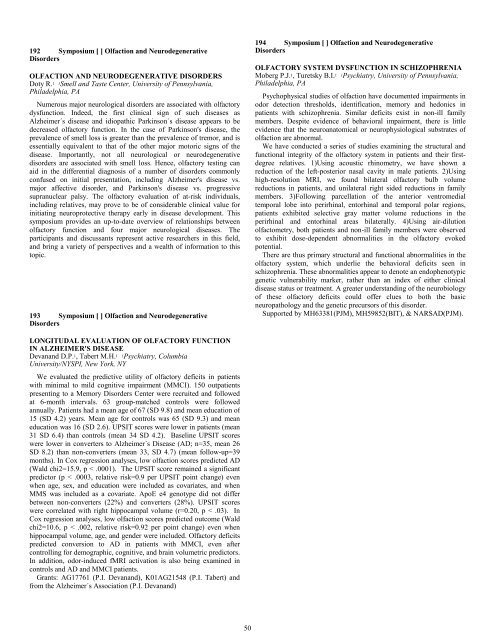Givaudan-Roure Lecture - Association for Chemoreception Sciences
Givaudan-Roure Lecture - Association for Chemoreception Sciences
Givaudan-Roure Lecture - Association for Chemoreception Sciences
Create successful ePaper yourself
Turn your PDF publications into a flip-book with our unique Google optimized e-Paper software.
192 Symposium [ ] Olfaction and Neurodegenerative<br />
Disorders<br />
OLFACTION AND NEURODEGENERATIVE DISORDERS<br />
Doty R. 1 1Smell and Taste Center, University of Pennsylvania,<br />
Philadelphia, PA<br />
Numerous major neurological disorders are associated with olfactory<br />
dysfunction. Indeed, the first clinical sign of such diseases as<br />
Alzheimer´s disease and idiopathic Parkinson´s disease appears to be<br />
decreased olfactory function. In the case of Parkinson's disease, the<br />
prevalence of smell loss is greater than the prevalence of tremor, and is<br />
essentially equivalent to that of the other major motoric signs of the<br />
disease. Importantly, not all neurological or neurodegenerative<br />
disorders are associated with smell loss. Hence, olfactory testing can<br />
aid in the differential diagnosis of a number of disorders commonly<br />
confused on initial presentation, including Alzheimer's disease vs.<br />
major affective disorder, and Parkinson's disease vs. progressive<br />
supranuclear palsy. The olfactory evaluation of at-risk individuals,<br />
including relatives, may prove to be of considerable clinical value <strong>for</strong><br />
initiating neuroprotective therapy early in disease development. This<br />
symposium provides an up-to-date overview of relationships between<br />
olfactory function and four major neurological diseases. The<br />
participants and discussants represent active researchers in this field,<br />
and bring a variety of perspectives and a wealth of in<strong>for</strong>mation to this<br />
topic.<br />
193 Symposium [ ] Olfaction and Neurodegenerative<br />
Disorders<br />
LONGITUDAL EVALUATION OF OLFACTORY FUNCTION<br />
IN ALZHEIMER'S DISEASE<br />
Devanand D.P. 1, Tabert M.H. 1 1Psychiatry, Columbia<br />
University/NYSPI, New York, NY<br />
We evaluated the predictive utility of olfactory deficits in patients<br />
with minimal to mild cognitive impairment (MMCI). 150 outpatients<br />
presenting to a Memory Disorders Center were recruited and followed<br />
at 6-month intervals. 63 group-matched controls were followed<br />
annually. Patients had a mean age of 67 (SD 9.8) and mean education of<br />
15 (SD 4.2) years. Mean age <strong>for</strong> controls was 65 (SD 9.3) and mean<br />
education was 16 (SD 2.6). UPSIT scores were lower in patients (mean<br />
31 SD 6.4) than controls (mean 34 SD 4.2). Baseline UPSIT scores<br />
were lower in converters to Alzheimer´s Disease (AD; n=35, mean 26<br />
SD 8.2) than non-converters (mean 33, SD 4.7) (mean follow-up=39<br />
months). In Cox regression analyses, low olfaction scores predicted AD<br />
(Wald chi2=15.9, p < .0001). The UPSIT score remained a significant<br />
predictor (p < .0003, relative risk=0.9 per UPSIT point change) even<br />
when age, sex, and education were included as covariates, and when<br />
MMS was included as a covariate. ApoE e4 genotype did not differ<br />
between non-converters (22%) and converters (28%). UPSIT scores<br />
were correlated with right hippocampal volume (r=0.20, p < .03). In<br />
Cox regression analyses, low olfaction scores predicted outcome (Wald<br />
chi2=10.6, p < .002, relative risk=0.92 per point change) even when<br />
hippocampal volume, age, and gender were included. Olfactory deficits<br />
predicted conversion to AD in patients with MMCI, even after<br />
controlling <strong>for</strong> demographic, cognitive, and brain volumetric predictors.<br />
In addition, odor-induced fMRI activation is also being examined in<br />
controls and AD and MMCI patients.<br />
Grants: AG17761 (P.I. Devanand), K01AG21548 (P.I. Tabert) and<br />
from the Alzheimer´s <strong>Association</strong> (P.I. Devanand)<br />
50<br />
194 Symposium [ ] Olfaction and Neurodegenerative<br />
Disorders<br />
OLFACTORY SYSTEM DYSFUNCTION IN SCHIZOPHRENIA<br />
Moberg P.J. 1, Turetsky B.I. 1 1Psychiatry, University of Pennsylvania,<br />
Philadelphia, PA<br />
Psychophysical studies of olfaction have documented impairments in<br />
odor detection thresholds, identification, memory and hedonics in<br />
patients with schizophrenia. Similar deficits exist in non-ill family<br />
members. Despite evidence of behavioral impairment, there is little<br />
evidence that the neuroanatomical or neurophysiological substrates of<br />
olfaction are abnormal.<br />
We have conducted a series of studies examining the structural and<br />
functional integrity of the olfactory system in patients and their firstdegree<br />
relatives. 1)Using acoustic rhinometry, we have shown a<br />
reduction of the left-posterior nasal cavity in male patients. 2)Using<br />
high-resolution MRI, we found bilateral olfactory bulb volume<br />
reductions in patients, and unilateral right sided reductions in family<br />
members. 3)Following parcellation of the anterior ventromedial<br />
temporal lobe into perirhinal, entorhinal and temporal polar regions,<br />
patients exhibited selective gray matter volume reductions in the<br />
perirhinal and entorhinal areas bilaterally. 4)Using air-dilution<br />
olfactometry, both patients and non-ill family members were observed<br />
to exhibit dose-dependent abnormalities in the olfactory evoked<br />
potential.<br />
There are thus primary structural and functional abnormalities in the<br />
olfactory system, which underlie the behavioral deficits seen in<br />
schizophrenia. These abnormalities appear to denote an endophenotypic<br />
genetic vulnerability marker, rather than an index of either clinical<br />
disease status or treatment. A greater understanding of the neurobiology<br />
of these olfactory deficits could offer clues to both the basic<br />
neuropathology and the genetic precursors of this disorder.<br />
Supported by MH63381(PJM), MH59852(BIT), & NARSAD(PJM).

















